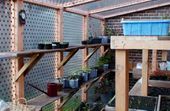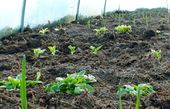Difference between revisions of "Greenhouse"
From eagle-rock.org
| Line 11: | Line 11: | ||
File:Greenhouse in winter.jpg|Greenhouse in winter. All these vegetables were sown or planted in November. They can withstand moderate freezing temperatures and will begin grow quicker when the first spring days arrive. [[Garlic]], [[onion]]s, [[corn salad]], [[fava bean]]s, [[pea]]s, [[spinach]]. | File:Greenhouse in winter.jpg|Greenhouse in winter. All these vegetables were sown or planted in November. They can withstand moderate freezing temperatures and will begin grow quicker when the first spring days arrive. [[Garlic]], [[onion]]s, [[corn salad]], [[fava bean]]s, [[pea]]s, [[spinach]]. | ||
File:Small cold frame.JPG|A small cold frame. I built it in one day. Size: 3 x 4 m. Covered with UV proof plastic. | File:Small cold frame.JPG|A small cold frame. I built it in one day. Size: 3 x 4 m. Covered with UV proof plastic. | ||
| + | File:Greenhouse - 100911.JPG | ||
</gallery> | </gallery> | ||
Revision as of 09:36, 3 January 2012
This page is to prepare and collect information for one or more chapters in the course. --John Eagles 23:14, 26 December 2011 (PST)
Chunks of information
- March 21, 2011 - The first day of spring. This year it also was the first day that felt like spring. In addition to a normal greenhouse, i like to work with a cold frame, so i built one of cheap materials. Cold frames are excellent for sowing seeds of plants that later are planted in the open, such as cabbage and salad. Cold frames also allow vegetables to be grown earlier in spring and later in autumn. The height of my cold frame is such that it can accommodate pepper plants. To start with, i planted a species of potatoes that grow very fast. Having them in a cold frame they are protected against frost and harvest will be three weeks earlier. By that time, the potatoes of last year won't taste very well anymore and are are depleted from vitamins.
Gallery
A sun room, or greenhouse adjacent to the living house. This one is 10 x 20 feet and is kept above freezing temperatures with the heat of a wood furnace inside the house. Plants that cannot bear frost can winter here. It is also used to sow crops in pots starting in January, such as tomatoes, eggplants, sweet and hot peppers.
Greenhouse in winter. All these vegetables were sown or planted in November. They can withstand moderate freezing temperatures and will begin grow quicker when the first spring days arrive. Garlic, onions, corn salad, fava beans, peas, spinach.
See also
External links
- Cold frame "... a cold frame is a transparent-roofed enclosure, built low to the ground, used to protect plants from cold weather." Wikipedia
- Greenhouse Research Topics
- Greenhouse "A greenhouse (also called a glasshouse) is a building where plants are grown. These structures range in size from small sheds to very large buildings..." Wikipedia
- Greenhouse vegetables
- Growing Vegetables In Greenhouses
- SEASON EXTENDING WITH OUR SOLAR POD





